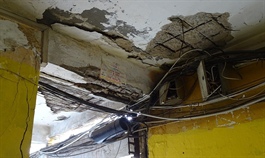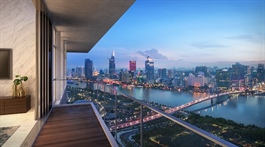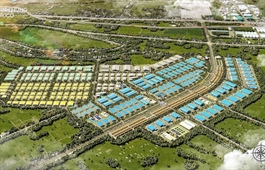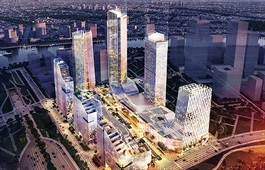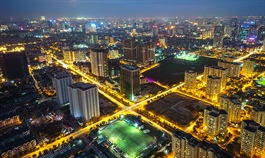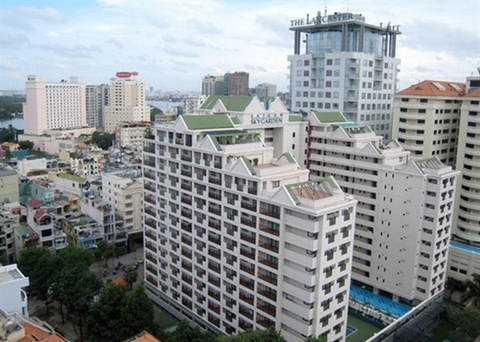Rosy outlook for real estate investment
Rosy outlook for real estate investment
In 2020, Vietnam’s residential real estate prices continued rising, despite the major hit to the economy from COVID-19, and the country’s industrial real estate sector boomed, prompted by US-China trade tensions.

Don Lam - CEO, VinaCapital Group
|
In 2021, residential real estate prices are likely to climb for a variety of reasons, and we expect the industrial sector to continue booming as multinational manufacturers accelerate diversifying their production from China to Vietnam.
That said, it is becoming harder for foreign real estate investors to make money in Vietnam because of stiffer competition from increasingly sophisticated local investors and developers. For that reason, we believe the best way for foreign investors to get exposure to Vietnam’s real estate market – which is arguably one of the most attractive markets in the world – is to partner with existing players who are on the ground and who understand those investors’ requirements.
Resilient residential market
Rents in Ho Chi Minh City and Hanoi plunged in 2020, which was not surprising given everything that happened last year. However, residential real estate prices increased substantially because the supply of new housing units was constrained (and well below demand), and because interest rates also dropped last year.
The unusual combination of falling rents and soaring residential real estate prices was a global phenomenon that is unlikely to be repeated in 2021, but supply constraints will continue putting upward pressure on Vietnam’s residential real estate prices in 2021.
We estimate that the combined demand for new housing units in Ho Chi Minh City and Hanoi is around 200,000 units per year, given Vietnam’s circa 3 per cent per year urban population growth rate, and given an estimated 100,000 per year of new household formations (that is, people getting married).
In contrast, only about 60,000 new housing units per year have been launched for sale in recent years, and that figure is likely to have dropped to around 40,000 in 2020 due to COVID-19 as well as to legal and zoning issues that have severely slowed new project approvals in Ho Chi Minh City since 2018.
It is very likely that the project approval issues that plagued the Ho Chi Minh City market over the last two years, and started to impact the Hanoi market in 2019, will begin to be resolved into this year. That said, it is likely to take until at least 2022 before the supply and demand in Vietnam’s residential real estate market is balanced out, because of the time it will take to engage a new cohort of civil servants that is empowered to resume approving more residential projects, and because of the time it will take to actually construct those new apartment buildings and other residential developments after the required project approvals are secured.
Furthermore, the long-term outlook for Vietnam’s residential real estate market is very strong because the country’s GDP growth is likely to range between 6 and 7 per cent over the next decade; because mortgage financing is becoming more and more widely available (Vietnam’s mortgage penetration rate was still around 7 per cent of GDP in 2020, versus nearly 25 per cent in Thailand); and because real estate prices are still affordable for most emerging middle-class consumers.
In addition, we estimate that a typical middle-income couple can afford to purchase a mid-tier apartment (circa $1,300 per square metre) by getting a mortgage from the bank, in which their monthly mortgage payments are equivalent to about one-third of their combined monthly salaries. This ratio is typically considered within the range of affordability.
Booming industrial sector
Trade tensions between the United States and China began escalating about three years ago. Since then, lease rates in industrial zones (IZs) in Vietnam have been increasing at a 10-20 per cent annual rate, and it has become difficult to find even 5-10 hectares of industrial land to immediately occupy within 30km of Ho Chi Minh City’s central business districts (CBD).
Multinational manufacturers had already been relocating some of their production out of China and to Vietnam before the US-China trade tensions erupted, because factory wages in China had essentially tripled over the last decade, and wage inflation in that country was about double that in Vietnam over that time, in USD terms.
Donald Trump’s initiation of the US-China trade war accelerated diversification of those corporations in terms of their production activities out of China, and then COVID-19 intensified those diversification efforts. That is because supply chain disruptions faced at the height of China’s COVID-19 outbreak showed manufacturers that had previously believed had global supply chains actually just had Chinese supply chains.
For all of those reasons, about 20 per cent of the factories that are located in China are likely to leave the country over the next 10 years, according to surveys published by Union Bank of Switzerland and others.
Most manufacturers leaving China prefer to relocate to Vietnam, according to surveys published by Standard Chartered, the Japan External Trade Organization (JETRO), and others. We believe that Vietnam has the capacity to absorb a good amount of that relocated production.
Vietnam’s manufacturing sector has consistently accounted for less than 20 per cent of the country’s GDP in recent years, but the contribution of the manufacturing sector in every other “Asian Tiger” economy peaked at over 30 per cent of GDP, which gives an indication of how much bigger Vietnam’s industrial sector is likely to get over the next decade.
Furthermore, the government strategy to “build a nest to welcome eagles” by improving the country’s physical infrastructure and by raising Vietnam’s ease-of-doing-business rankings will help ensure industrial activity continues to grow in the years ahead.
All of this clearly augurs well for a continued boom in the demand for Vietnam’s IZ space for years to come. For that reason, it is not surprising that all of the local commercial real estate brokers are significantly growing their industrial real estate brokerage teams to field the growing volume of inquiries from foreign manufacturers and logistics providers.
Landscape for non-nationals
Foreign direct investment (FDI) into Vietnamese real estate was more-or-less unchanged in 2019 and 2020, although the composition of FDI shifted because investment into hospitality projects understandably fell, but that into industrial real estate soared – accounting for about one-third of the country’s registered real estate FDI last year.
Also, foreign real estate investors now face stiffer competition from increasingly sophisticated local players. For example, inquiries from overseas financiers about distressed real estate investment opportunities surged in 2020, but those investors found that the number of such projects in Vietnam was limited, and that local funders were better positioned to take advantage of those opportunities.
Also, the acquisition of “trophy properties” such as high-profile resorts and apartment buildings that are typically of interest to foreign investors with ample financial resources is becoming increasingly dominated by local ones instead.
For that reason, it is not surprising that the advisory businesses of leading commercial real estate brokers like Savills, CBRE, and Cushman & Wakefield are increasingly dominated by mandates for local investors. Furthermore, local real estate developers raised over $7 billion in 2020 by issuing corporate bonds, so all of these discussed trends are likely to continue in 2021.
Foreign investors are increasingly focusing on projects in the suburbs because overseas developers have had difficulty sourcing appropriate plots of land near the CBD’s of the country’s major cities. Additionally, infrastructure development is making it possible for people to live further from the CBD.
As for industrial real estate, foreigners have been investing in the industrial sector via joint ventures with existing local players and have been shifting their focus from nearby Haiphong to the periphery of Hanoi. Also, the IZ business in Vietnam is still fairly fragmented compared to other countries in the region.
Finally, South Korean investors accounted for over half of Vietnam’s registered real estate FDI in 2020, and that high level of interest is likely to continue going forward for a variety of reasons. South Korea’s GDP growth will slow over the next decade, partly because the country’s population is set to decline at a faster rate than Japan’s currently is.
When Japan faced similar secular stagnation issues in the early 1990s, investors poured money into Southeast Asia as investment opportunities in their home market became less and less attractive as GDP growth slowed. We believe a similar phenomenon will drive South Korean investment into Vietnam for years to come.





